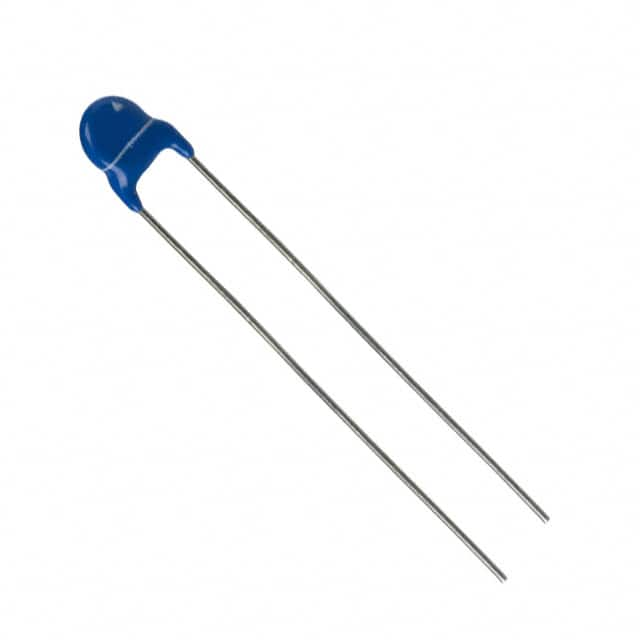B72205S0251K111 Product Overview
Introduction
The B72205S0251K111 is a component belonging to the category of varistors, commonly used for voltage clamping and transient surge protection in electronic circuits. This entry provides an overview of its basic information, specifications, pin configuration, functional features, advantages and disadvantages, working principles, application field plans, and alternative models.
Basic Information Overview
- Category: Varistors
- Use: Voltage clamping and transient surge protection in electronic circuits
- Characteristics: High energy absorption capability, fast response time, compact size
- Package: Radial leaded disc
- Essence: Protecting electronic devices from voltage spikes and surges
- Packaging/Quantity: Typically available in reels or bulk packaging
Specifications
- Model: B72205S0251K111
- Voltage Rating: 250V
- Nominal Discharge Current (8/20µs): 100A
- Maximum Energy (10/1000µs): 2.5J
- Operating Temperature Range: -40°C to +85°C
- Lead Material: Tin-plated copper
Detailed Pin Configuration
The B72205S0251K111 varistor has a radial leaded disc package with two leads for easy integration into circuit designs. The pin configuration includes a clear indication of the anode and cathode connections, ensuring proper orientation during installation.
Functional Features
- Voltage Clamping: Provides effective voltage clamping to protect sensitive electronic components.
- Transient Surge Protection: Rapidly responds to transient voltage surges, diverting excess energy away from the circuit.
- High Energy Absorption: Capable of absorbing high levels of energy during surge events, safeguarding connected devices.
Advantages and Disadvantages
Advantages
- Fast response time
- Compact size for space-constrained applications
- High energy absorption capability
Disadvantages
- Limited maximum energy handling capacity compared to larger varistors
- Sensitive to prolonged overvoltage conditions
Working Principles
The B72205S0251K111 operates based on the principle of non-linear resistance, where its resistance decreases as the applied voltage increases. During normal operation, it exhibits a high resistance, but when subjected to a surge, its resistance drops significantly, allowing it to shunt the excess current and protect downstream components.
Detailed Application Field Plans
The B72205S0251K111 varistor finds extensive use in various electronic systems, including: - Power supply units - Communication equipment - Industrial control systems - Consumer electronics - Automotive electronics
Detailed and Complete Alternative Models
For applications requiring different voltage ratings or energy absorption capabilities, alternative varistor models include: - B72205S0200K101 (200V, 1.25J) - B72205S0300K101 (300V, 3J) - B72205S0400K101 (400V, 4J)
In conclusion, the B72205S0251K111 varistor offers reliable voltage clamping and transient surge protection in a compact form factor, making it suitable for a wide range of electronic applications.
Word Count: 413
Lista 10 Vanliga frågor och svar relaterade till tillämpningen av B72205S0251K111 i tekniska lösningar
What is the B72205S0251K111 component used for in technical solutions?
- The B72205S0251K111 is a ceramic transient voltage suppressor (TVS) diode used to protect sensitive electronic components from voltage spikes and transients.
What are the key specifications of the B72205S0251K111?
- The B72205S0251K111 has a working voltage of 25V, a peak pulse current of 100A, and a low clamping voltage to provide effective protection.
How does the B72205S0251K111 contribute to circuit protection?
- The B72205S0251K111 provides overvoltage protection by diverting excess current away from sensitive components, preventing damage due to voltage surges.
In what applications is the B72205S0251K111 commonly used?
- The B72205S0251K111 is frequently used in telecommunications equipment, industrial control systems, automotive electronics, and other applications requiring robust transient voltage protection.
What are the advantages of using the B72205S0251K111 in technical solutions?
- The B72205S0251K111 offers fast response times, low leakage current, and high surge handling capability, making it an effective solution for protecting sensitive circuits.
How should the B72205S0251K111 be integrated into a circuit design?
- The B72205S0251K111 can be placed in parallel with the protected circuit, ensuring that any voltage spikes are safely diverted through the TVS diode.
What are the temperature considerations for the B72205S0251K111?
- The B72205S0251K111 has a wide operating temperature range, typically from -55°C to 150°C, allowing for reliable performance in various environmental conditions.
Are there any specific soldering or mounting requirements for the B72205S0251K111?
- The B72205S0251K111 is designed for surface mount applications and should be soldered using appropriate reflow techniques to ensure proper connection and reliability.
Can multiple B72205S0251K111 components be used in parallel for enhanced protection?
- Yes, multiple B72205S0251K111 components can be used in parallel to increase the overall surge handling capability and provide redundancy in critical applications.
What are the potential failure modes of the B72205S0251K111 and how can they be mitigated?
- Potential failure modes include thermal runaway and degradation due to prolonged exposure to high currents. Proper heat sinking and current limiting measures can help mitigate these risks.


